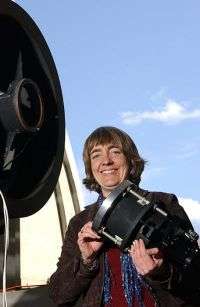UD astronomers coordinating international observatories in white-dwarf watch

Judi Provencal is star-struck, but not so much by the glitz and glam of Hollywood. You have to look heavenward through a telescope to see the object of her fascination--to pale stars called white dwarfs, their brilliance faded because all of their nuclear fuel has been burned up.
A white dwarf is a star that is “dying,” cooling down in the twilight of its life. It's what the sun will become in about 4 billion years, according to Provencal.
Starting Wednesday, March 26, Provencal--who is an assistant professor of physics and astronomy at the University of Delaware, director of the Delaware Asteroseismic Research Center (DARC), and resident astronomer at Mt. Cuba Astronomical Observatory in Greenville, Del.--will be coordinating some of the world's largest telescopes in a three-week-long “international observing run,” focusing on a white dwarf known as IU Vir in the constellation Virgo. The star's coordinates are 14012-1446.
The observing run will be conducted by the Whole Earth Telescope (WET), a worldwide network of observatories that work together to obtain continuous measurements of “pulsating” stars. Such stars change their shape or surface temperature as waves of energy travel through them. They are the basis of asteroseismology, a fledgling science that examines “starquakes” just as seismologists monitor earthquakes.
WET was initiated in 1986 by astronomers at the University of Texas and later was transferred to Iowa State University. Three years ago, the coordination of WET moved to the University of Delaware through the leadership of Provencal and Harry Shipman, the Annie Jump Cannon Professor of Astronomy at UD, and with the financial support of the Crystal Trust Foundation.
The upcoming observing run will involve more than 20 of WET's observatories, including one of the largest telescopes on the planet--the Southern African Large Telescope (SALT) in Sutherland, South Africa. It has a 10-by-11-meter (32-by-36 foot) hexagonal, segmented mirror and can record stars, galaxies and quasars a billion times too faint to be seen by the unaided eye--“as faint as a candle flame at the distance of the moon,” according to its Web site.
From March 26 through May 1, the lenses of these major telescopes will focus on IU Vir to provide 24/7 coverage. Like an international relay team, observers at Mt. Cuba in Delaware will study the white dwarf until sunrise, and then observers at Macdonald Observatory in Fort Davis, Texas, and at Kitt Peak National Observatory in Tucson, Arizona, will stand watch while the star is in their sky, followed by observers in Hawaii, then New Zealand, Australia, China and so on, around the globe.
All of the data will be transmitted to UD for analysis. Provencal and colleagues Susan Thompson, assistant director of DARC, and Teresa Holton, program coordinator, will operate the command center during the observing run, monitoring the observatories and their daily data transmissions via a Web site.
As Provencal reminds us, when we look up at the stars, the light we see has traveled millions of miles through space. It's the only artifact we have of the stars, yet this light carries with it a lot of information, allowing scientists to determine such characteristics as a star's surface composition, temperature and motion toward or away from us.
“Pulsating stars such as the white dwarf oscillate, and how they oscillate lets us determine what they look like inside,” Provencal explains. “Let's say you have a silver bell, and you ring it. It will make a certain sound. Now you have an aluminum bell that is the same shape as the silver bell. If you ring it, it won't sound like the silver bell. It will have its own tone. Stars do that, too. I like to think of our work as listening to the 'music of the stars,'” she says, smiling.
Besides giving scientists more detailed information about IU Vir, the data collected will include clues as to what is going on inside the sun because a white dwarf is the exposed core of what was once a star like the sun, according to Provencal.
“What we do might be called 'forensic astronomy,'” Provencal says. “If we can dig around in the innards of a white dwarf, and determine what it ate for lunch, how much it ate, and how quickly it ate, we can understand what is going on inside our own sun much better. We'll look at the pulsations of the star, take the frequencies at which it pulsates, and develop a model of it. In that way, this dead star which was once like the sun will help improve our understanding of the sun.”
Also, Provencal says that white dwarfs are good timekeepers, and as such, hold clues about the age of the cosmos.
“Once a white dwarf forms, all it does is sit and cool, so we can measure the temperature of a white dwarf, and, using some theoretical understandings, figure out how long it took the star to cool to that temperature, and hence determine how old it is,” Provencal says. “The coolest white dwarf we know of is about 2,500 degrees,” she notes. “This corresponds to an age for the galaxy of about 10 billion years.”
Source: University of Delaware





















